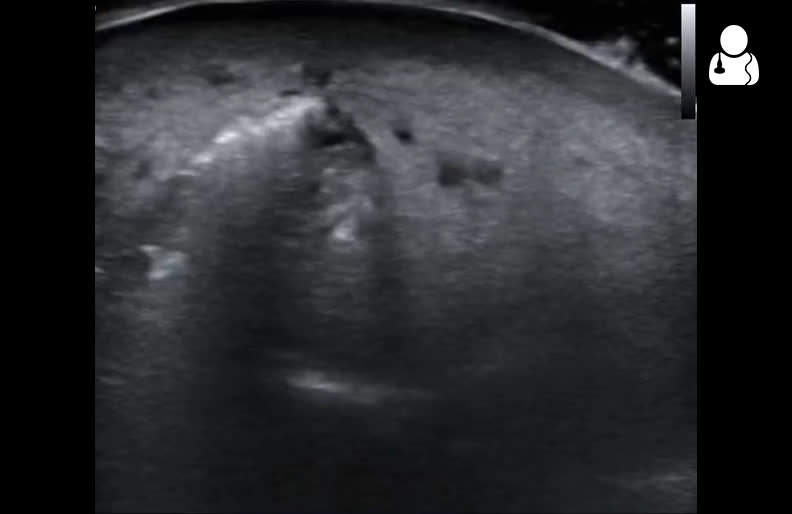42 year old female with no past medical history presents with increasing foot pain over the past 5 days. She reports that she has had decreasing sensation in the plantar surfaces of both her feet over the past few months, but did not think anything of it. She also endorses subjective fevers and nausea.

Answer: Necrotizing fasciitis (NF)
The ultrasound transducer was placed in the affected area, and evidence of cellulitis was visualized: hyperechoic soft tissue “islands” were seen surrounded by fluid (AKA cobblestoning). Also, evidence of subcutaneous air was visualized with shadowing seen beneath the gas. This gas obscures visualization of deeper structures.

- NF is a deadly disease, with the morbidity and mortality ranging from 25-75%.1 Traditionally NF has been primarily a clinical diagnosis2 but operative exploration remains the gold standard.3
- Plain x-rays may show the presence of subcutaneous gas as a specific findings, however it is reported to only be present in 25% of patients, and it’s absence cannot be used to exclude NF.4
- Computer tomography has been demonstrated to have a sensitivity of 80%-100% in detecting NF with excellent specificity.1,5
- Ultrasound can be used in the evaluation of suspected soft-tissue infections and has been shown to reliably differentiate cellulitis from abscess. One study found that ultrasound had a sensitivity of 98% and a specificity of 88% for the detection of NF, compared to clinical examination which had a sensitivity of 86% and a specificity of 70%6
- In a study of 62 patients with suspected NF with operative exploration as a gold standard, US was found to have a sensitivity of 88.2%, a specificity of 93.3%, a positive predictive value of 83.3%, and a negative predictive value of 95.4%7
- A linear probe should be used and copious transducer jelly placed to decrease pressure on the affected area. Scanning in the longitudinal and transverse orientations are equally beneficial.
- Criteria used for the diagnosis of NF on US include visualization of gas in tissue planes, diffuse thickened subcutaneous tissue and fluid collection >4mm in depth along the fascial plane.7
- Zacharias N, Velmahos GC, Salama A. Diagnosis of necrotizing soft tissue infections by computed tomography. Archives of surgery (Chicago, Ill. : 1960). 145(5):452-5. 2010. [pubmed]
- Castleberg E, Jenson N, Dinh VA. Diagnosis of Necrotizing Faciitis with Bedside Ultrasound: the STAFF Exam. The western journal of emergency medicine. 15(1):111-3. 2014. [pubmed]
- Sarani B, Strong M, Pascual J, Schwab CW. Necrotizing fasciitis: current concepts and review of the literature. Journal of the American College of Surgeons. 208(2):279-88. 2009. [pubmed]
- Lim YJ, Yong FC, Wong CH, Tan AB. Necrotising fasciitis and traditional medical therapy– a dangerous liaison. Annals of the Academy of Medicine, Singapore. 35(4):270-3. 2006. [pubmed]
- Wysoki MG, Santora TA, Shah RM, Friedman AC. Necrotizing fasciitis: CT characteristics. Radiology. 203(3):859-63. 1997. [pubmed]
- Squire BT, Fox JC, Anderson C. ABSCESS: applied bedside sonography for convenient evaluation of superficial soft tissue infections. Academic emergency medicine : official journal of the Society for Academic Emergency Medicine. 12(7):601-6. 2005. [pubmed]
- Yen ZS, Wang HP, Ma HM, Chen SC, Chen WJ. Ultrasonographic screening of clinically-suspected necrotizing fasciitis. Academic emergency medicine : official journal of the Society for Academic Emergency Medicine. 9(12):1448-51. 2002. [pubmed]




